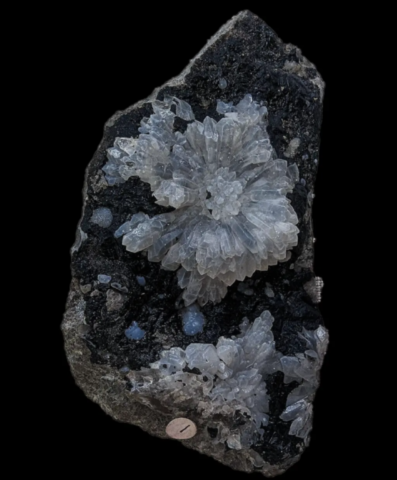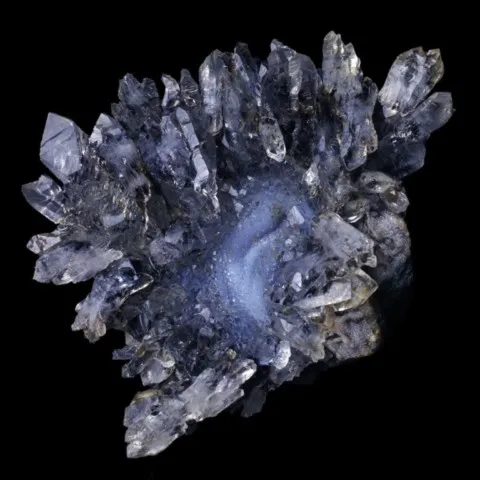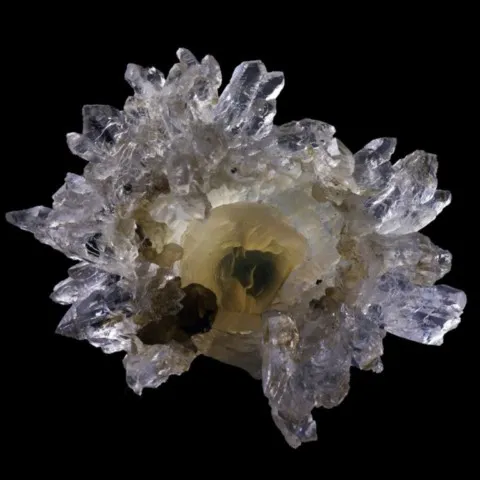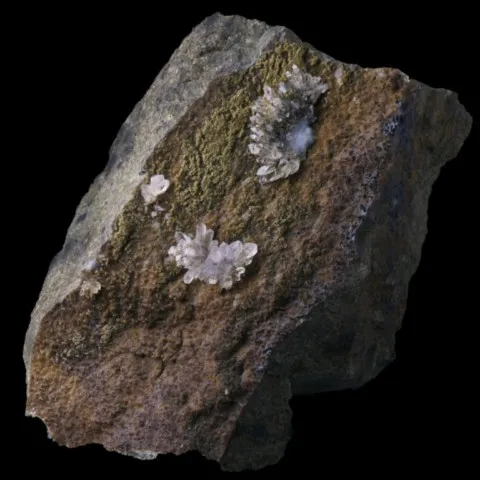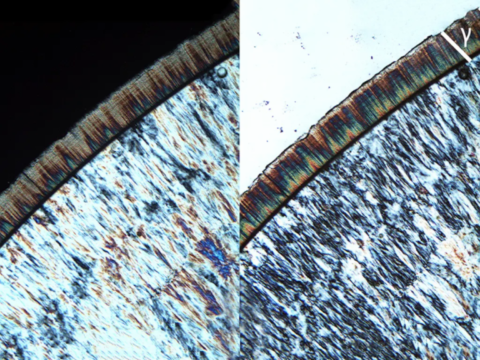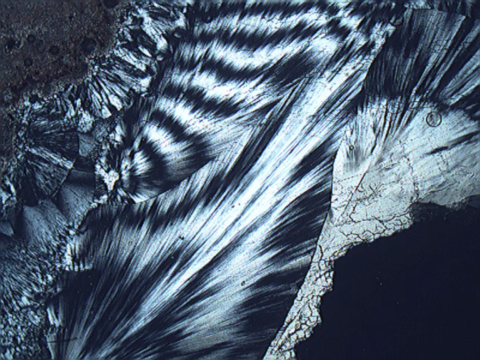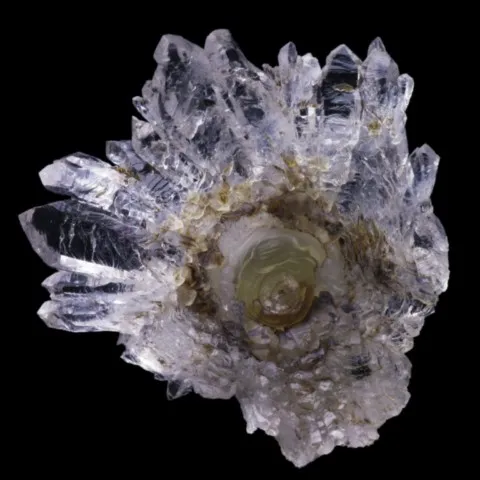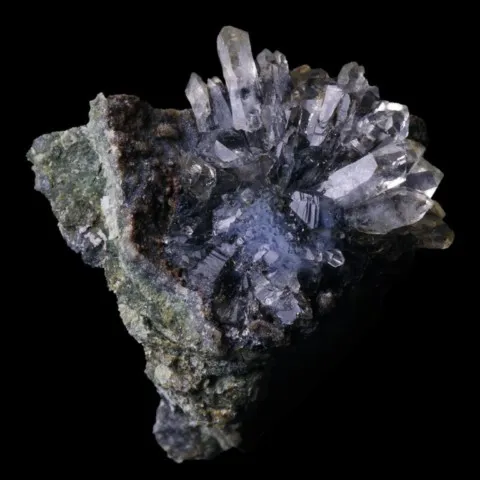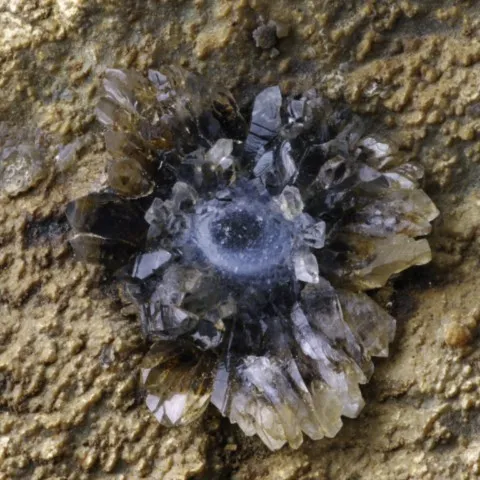Quartz flowers from Pont-du-Château - France
Located on the west bank of the Allier at Pont-du-Château, the Champs des Poix mine, now inaccessible, remains an iconic site for mineralogy enthusiasts. The site is renowned for its quartz crystals, some of them impressive in size for their geological context, as well as its chalcedony balls, also of considerable size. These mineralizations are often encrusted with a white film of lussatite, making them a real treasure trove for enthusiasts and the curious. Many museums contain specimens collected in the 19th century, including the Musée Lecoq in Clermont-Ferrand, the Musée de Géologie in Lausanne (Switzerland) and the Natural History Museum in London. Today, they are much rarer on the market...
Right photo : Quartz flower covered with a milky film of lussatite and blue lussatite pearls on bituminous nugget from the Champs de Poix Mine, Pont-du-Château, Puy-de-Dôme, France - Collection of the Natural History Museum, London - © Ralph Jolyon
The story of a rediscovery...
During the 2000's, Mikaël Boullot carried out a number of surveys on this site. This site, once the scene of mining activities, stands out for its unique geological environment. The slippery limestone slabs lining the river have been a playground for many a mineral seeker.
It was by observing the outcrops revealed by the low water level of the Allier River during the summer months that Mikaël was able to reveal the first clues to these limestone layers. Small traces of guttular siliceous pearls and small quartz crystals were identified, arousing his keen interest.
A turning point in the exploration of the site came in 2008, when, taking advantage of an exceptionally low water level, Mikaël and one of his colleagues uncovered a remarkable structure : a fault filled with sand and grasses in a layer of peperite (a breccia resulting from explosive volcanic activity linked to the meeting of basaltic magma and waterlogged sediments). As we dug into this fault, a magnificent discovery emerged : a lussatite “flower” about 2 cm in diameter ! But the surprise didn't stop there. When the fault was cleared over a length of almost 4 metres and a depth of 70 cm, several medium-sized lussatite flowers (3 cm in diameter) were discovered, accompanied by small, often dark beige pearls. These specimens were delicately set on rhombohedral microcrystals of brown calcite. In addition to flowers and pearls, microcrystals of cubic pyrite were found, adding a metallic, golden touch to the mineralogical picture of this fault. As for the peperite, it features small cavities filled with tiny, perfectly transparent analcime crystals. Most specimens, devoid of matrix due to alteration of the first rock layers, illustrate the fragility and ephemeral beauty of these mineralizations.
Quartz, chalcedony or lussatite ?
Optical microscopy using analyzed polarized light reveals that the siliceous flowers of Pont-du-Château are composed of a chalcedony core. Chalcedony, a fibrous, micro-crystallized variety of quartz, contains interstitial water and stands out for its unique organization. Under polarization, the chalcedony fibers reveal periodic extinction bands, a feature that attests to the rotation of the fibers around their axis of elongation. These fibers then extend to form automorphic quartz crystals, which make up the petals of flowers, giving these structures their remarkable appearance.
An essential distinction between these formations and those composed of lussatite lies in the optical elongation of the fibers. Whereas lussatite, described by Mallard in 1890, has a positive elongation, the quartz fibers of the Pont-du-Château siliceous flowers are characterized by a strictly negative elongation. This difference is a valuable criterion for separating these mineralizations. Furthermore, the only positive-elongation fibers observed in these formations appear as thin films covering the surface of quartz crystals. These films give the crystals a milky appearance, similar to that of the sample preserved at London's Natural History Museum (main photo). The “lussatite flowers” are therefore not lussatite, although these mineralizations are extremely aesthetic.
Precautions for specimens on matrix
Pont-du-Château quartz flowers grow on a peperite, a volcanic rock formed by the interaction of magma and wet sediments. This matrix is particularly sensitive to hydration and dehydration cycles, making it fragile when exposed to water. Exposure to water, particularly through immersion or rinsing, can lead to rapid degradation of the rock, making it brittle and causing specimens to disintegrate. It is therefore essential never to underwater these quartz flowers, in order to preserve their natural support and structural integrity.
References :
BORNET, R. (2009). La lussatite, une variété microcristalline de silice. TER Université Blaise Pascal de Clermont-Ferrand.
Collectif. (2015). La lussatite, l’opale d’Auvergne et autres trésors de la Limagne (Puy-de-Dôme). Hors-série n°21 de la revue Le Règne Minéral. Éditions du Piat, 84 pages
Mallard, E. (1890). Sur la lussatite, nouvelle variété minérale critallisée de silice. Bulletin de la Société française de Minéralogie, tome n°13, pp. 63-66.

